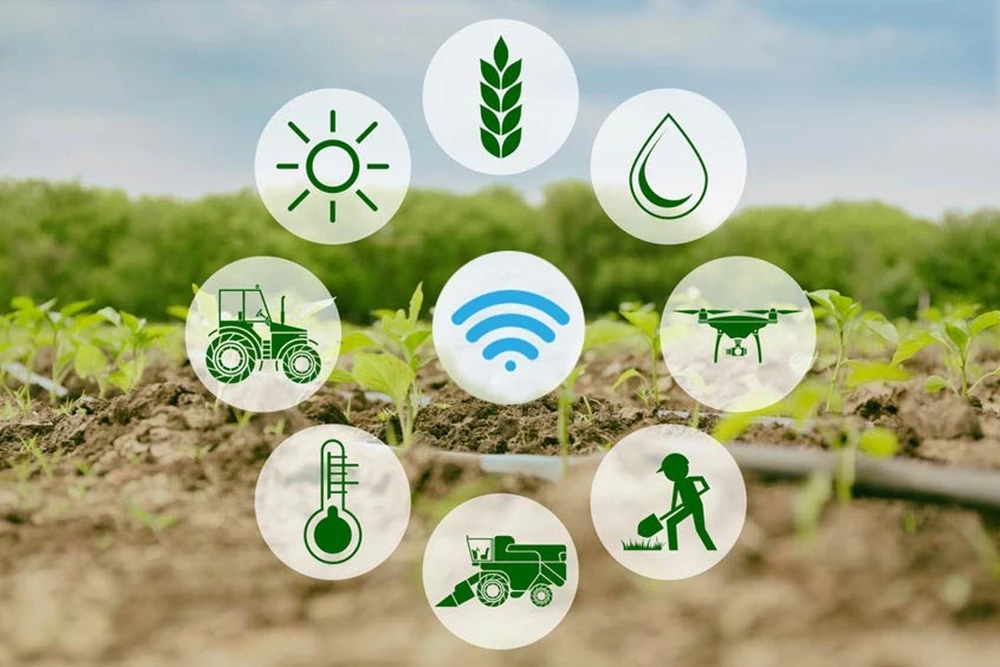
Overview
The global smart farming market is expected to reach $23.14 Billion by 2022. This is a precise raise of CAGR (Compound Annual Growth Rate) of 19.3 %, from 2017 to 2022.– Market Intelligence Report, BIS Research. On the other hand, FAO predicts that 9.6 billion individuals are going to inhabit the world by 2050. To sustain this massive number, a minimum increase of 70% in food production is requisite to be achieved by 2050. Considering other factors such as limited land and freshwater availability, and climate change impacts, Smart farming, also called Precision farming, is ideally the best practical way out to address these challenges.
One of the most common use cases of IoT in smart agriculture is Crop monitoring. In the case of weather condition monitoring, sensors for crop monitoring also collect all information like crop health, humidity, precipitation, temperature, and other parameters. Thus, you can monitor your crop growth and any anomalies to effectively prevent any diseases or infestations that can harm your yield. If there are any deviations from set normal levels, farmers get to identify them beforehand and take appropriate remedial actions. Also, sensors help farmers determine when the best moment to plant crops and harvest them. Remote control of climate, insect, and disease monitoring is exercised via smart farming techniques.
Advantages of IoT in the Agricultural Sector
Smart farming enables the farmer to maximize their yield against minimum usage of resources like seeds, fertilizers and pesticides, and water. For this, different types of sensors are mounted at several places, depending upon the requirement. Using them, farmers can track their crop cultivation factors such as fruit or bark diameter, leaf wetness, atmospheric pressure, rainfall, wind direction and speed, solar radiation, humidity, soil and air temperature, and more. Let us check out some of the topmost advantages of IoT in farming.
- Data-driven decisions based on collected data: With the help of sensors, farmers get access to crop-related data. Based on those actionable insights, they can make better data-driven decisions that help in improving their crop profitability.
- Reduced Risks: As crop cultivators are up-to-date with essential information, they are in a position to predict prospective risks and challenges at some levels. This helps improve sales and reduce risk.
- Business Automation: With mundane tasks getting handled through automation, crop cultivators can focus on other areas that need priority, which further leads to maximized efficiency levels and profits.
- Enhanced product volumes and quality: It is seen that analysed decisions based on real-time alerts help maintain optimized water levels, crop free from pesticides, and help achieve an overall healthy harvest.
Challenges to Smart Farming
Undoubtedly, smart agriculture is at a boom across the globe, and there still lies an enormous scope of improvements, with rapid advancements taking place now and then. However, there exist several challenges that turn attention. Here are some of the key challenges to smart farming-
- Concerns related to security and data thefts are a risk in practically all types of ‘connected systems’, and smart agriculture is not an exception from that.
- Available technologies often don’t follow the same technology standards/platforms – as a result of which, there is a lack of uniformity in the final analysis done by end-users. In many instances, the creation of an additional gateway(s) becomes essential for data translation and transfer across standards.
- Making sense from big data is certainly not an easy task. It is next to impossible to monitor and manage every single data point and reading on a daily/weekly basis, over the entire growing seasons. Although digital agriculture is increasingly becoming big data-driven – but the technology is helpful only when users can actually ‘make sense’ of the information available to them.
- Indoor farming is still a challenge for a large number of current and prospective adapters of precision farming. With the value of the global vertical farming industry projected to go beyond $4 billion by 2021, technology support for indoor farming demands increase attention. Farmers need to be able to rely on technology to create an optimal growing environment for indoor plants.
Solutions to these challenges
The Method83 IoT platform is one solution that effectively addresses and resolves such issues and hindrances for broad IoT deployment and value creation. An IoT cloud solution powered by machine learning, deep data analytics, and autonomous actions, Method83 is enabling businesses to improve their ROI and reduce the time to market. The Disruptive ‘Method83’ Platform – Affordable, Fast, Secure, and Scalable IIoT Solutions. IoT83’s Method83 platform, with its integrated Application Builder tools, accelerates the creation of sophisticated and secure applications and simplifies at-scale IoT deployment, as well as on-going IoT operations, iterative development, and enhancements.
Method83 key benefits include built-in scalability and reliability, simplified IoT device connectivity, a rich suite of application creation tools and associated workflows, IoT analytics and automation, end-to-end data security, and multiple integrated services to enhance new IoT applications and services. The disruptive Method83 platform is an affordable, fast, secure, and scalable IIoT Solution.
IoT83 provides a game-changing path to Industrial IoT and Digital Transformation deployment. By combining a secure and scalable “one click deploy” platform, its suite of Application Development tools, and agile and efficient software services, Method83 transforms the complex work of “big data” deployments into a cost-effective and manageable path to a fast ROI. The IoT83 organization is an expert at identifying high-value IIoT use cases and then providing the device connectivity, data transport, cloud computing, big-data analytics, and connectivity to existing business systems to fully deliver on the promise of industrial IoT and digital transformation value creation.
